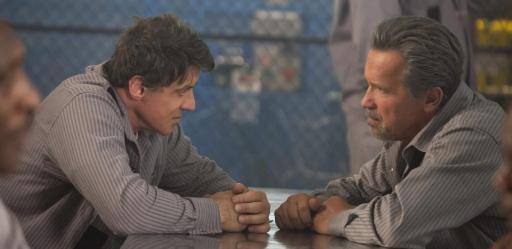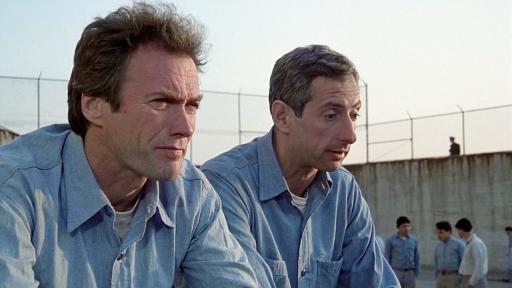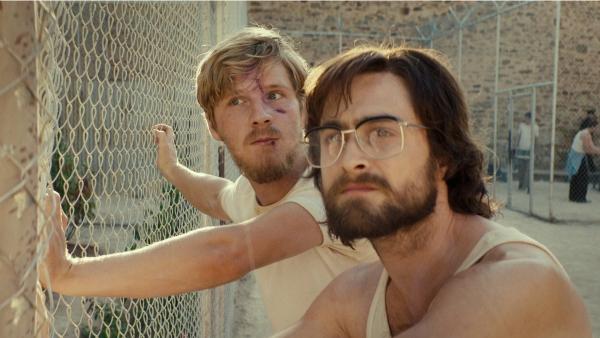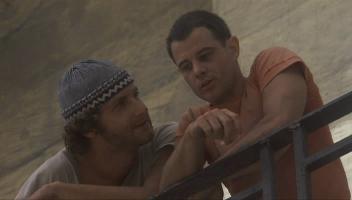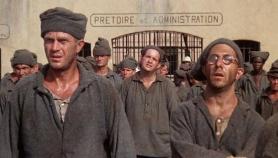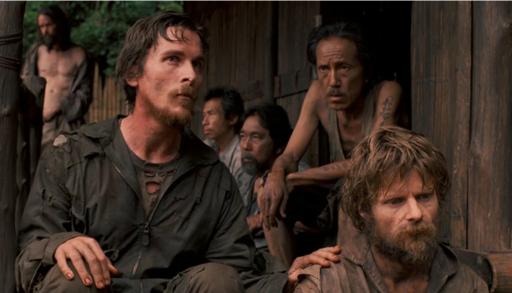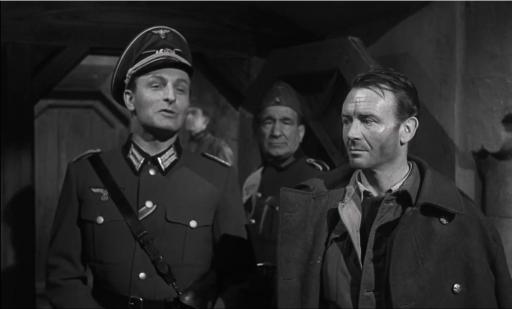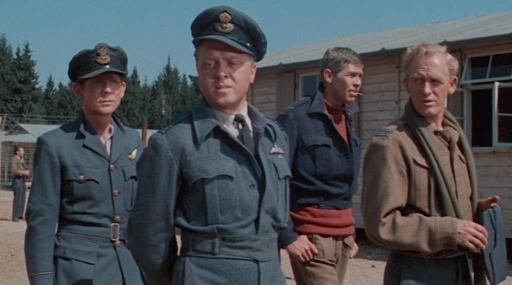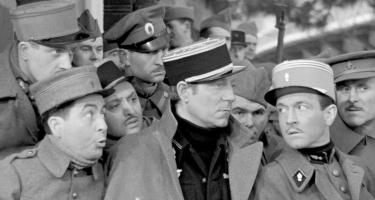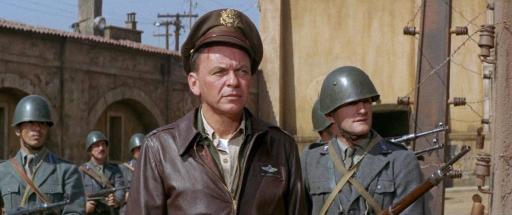Mikael Håfström’s “Escape Plan,” a well-known prison action thriller, is the first movie in which Sylvester Stallone and Arnold Schwarzenegger co-lead. The 2013 film centres on former prosecutor Ray Breslin, who is held captive in one of the most guarded prisons in the world, and his attempt to escape with fellow prisoner Emil Rottmayer. Rottmayer has secrets of his own, and Breslin is searching for answers.
Before time runs out and they are taken to an unknown location, the two resolve to stick together and make a daring escape from the prison. They encounter a variety of expected and unforeseen obstacles along the way. The film’s intriguing combination of mystery, action, and thrills keeps spectators interested all the way to the very end, leaving them wanting to learn more about other films that might evoke similar feelings, such as “Escape Plan.”
Cool Hand Luke (1967)
The 1965 novel of the same name by Donn Pearce served as the inspiration for Paul Newman’s film “Cool Hand Luke,” which is set in the 1950s. Under the direction of Stuart Rosenberg, the film centres on the fearless World War II veteran Luke, who is taken to a prison camp overseen by a meek rifleman and a strict warden. Luke refuses to follow the rules, even though tiny infractions carry harsh penalties. This creates a power struggle between Luke and the prison administration that lasts until one of them gives up. In both movies, protagonists choose to fight back for their freedom while demonstrating courage and persistence in the face of overwhelming hardship.
Escape from Alcatraz (1979)
“Escape From Alcatraz,” which was directed by Don Siegel, depicts Frank Morris (Clint Eastwood), who has escaped from every prison, when he is transferred to the most infamous and terrifying prison on the island, Alcatraz. Morris makes the decision to devise a method to get out of there as well, not ready to give up like the people who came before him. The movie is an adaptation of the same-titled book by J. Campbell Bruce and is based on the well-known 1962 Alcatraz Island prison escape. Similar to “Escape Plan,” “Escape From Alcatraz” is set in a high-security prison from which an escape appears unattainable—until individuals such as Morris, Rottmayer, and Breslin choose to accept the challenge.
Escape from Pretoria (2020)
The 2003 book “Inside Out: Escape from Pretoria Prison” by escaped prisoner Tim Jenkins served as the inspiration for the Australian prison film “Escape from Pretoria,” which was co-written and directed by Francis Annan. Daniel Radcliffe, Daniel Webber, and Mark Leonard Winter play three political inmates who carried out the actual tale of the 1979 jail break depicted in the movie. Two of the inmates were long-term inmates, while the other was a protestor who was actively speaking out against anti-apartheid.
The three had to go alone, even though they wanted to take many more inmates with them. However, their exoneration had a big impact because apartheid was abolished a year later. In contrast to the heroes of “Escape Plan,” the escapees in “Escape from Pretoria” were engaged in a societal movement, yet the major characters in both films make a big difference in the amount of hardship they face while attempting to escape.
Midnight Express (1978)
“Midnight Express,” a 1978 Turkish-American prison thriller directed by Alan Parker and adapted by Oliver Stone from Billy Hayes’ 1977 memoir, is a Turkish-American film. Billy’s attempt to break out of prison is referenced in the movie’s title. The story revolves around Brad Davis’ character, Hayes, a young student imprisoned in Turkey for trying to smuggle cannabis out of the nation. Billy’s journey is followed in the movie, from his decision to accept life in prison to his eventual preparation of a historic escape. The film’s use of reality is unabashedly raw, leaving viewers wondering about the terrifying experiences and struggles that the prisoners went through. If you’re interested in prison thrillers like “Escape Plan,” “Midnight Express” is well worth seeing.
Papillion (1973)
The historical prison drama “Papillon,” directed by Franklin J. Schaffner, is based on the autobiographical writings of French prisoner Henri Charrière. The film, which was filmed in isolated areas, stars Dustin Hoffman and Steve McQueen in the title roles. The story follows Henri Charriere (Papillon), who receives a prison sentence in French Guiana. There, he meets Louise Dega, a forger, and they decide to devise a scheme to break out of the jail. Similar to “Escape Plan,” “Papillon” likewise depicts the two main characters teaming up for their own benefit and to aid one another in getting out of the infamous prisons.
Rescue Dawn (2007)
“Little Dieter Needs to Fly,” a 1997 documentary film directed and written by Werner Herzog, served as the inspiration for “Rescue Dawn.” The film is based on the life of German-American aviator Dieter Dengler. The story follows Dengler (Christian Bale) during the Vietnam War as his aircraft is shot down and he is taken prisoner by the locals. The highly regarded movie follows Dengler during his confinement as he attempts to devise and carry out a scheme that will enable him and five other insane inmates to escape. Notwithstanding the numerous challenges they face each time they are on the verge of success, both films demonstrate the collaboration required to achieve a successful result.
The Colditz Story (1955)
Based on Pat Reid’s 1952 autobiographical novel about a British Army officer being imprisoned in Germany’s Colditz Castle during World War II, “The Colditz Story” is a British prisoner of war film. The film, directed by Guy Hamilton, follows Pat Reid and Richmond, two British officers, as they are apprehended and sent to the impenetrable German castle, where they organise the other detainees to find a way out. While the location of the protagonists’ captivity is where “Escape Plan” and “The Colditz Story” are similar, the latter work, which is a war autobiography, manages to emphasise the variety of true situations it deals with.
The Great Escape (1963)
Based on Paul Brickhill’s book of the same name, John Sturges’ highly regarded “The Great Escape” explores sub-themes of suspense and adventure. The story of the movie, which takes place in World War II, centres on the mass breakout of a group of British Commonwealth POWs from the infamous Stalag Luft III prison camp in Germany. The movie was greatly fictionalised in order to increase its overall commercial appeal. With Steve McQueen, Richard Attenborough, and James Garner playing key roles, the cast was outstanding. In contrast to “The Escape Plan,” which is set in a contemporary setting, “The Great Escape” is set during World War II. Nevertheless, both movies have heroes who, in spite of overwhelming odds, engage in complex planning to create a successful escape plan.
The Grand Illusion (1937)
The Grand Illusion, directed by Jean Renoir, is a French war film that chronicles the attempts of two French troops, Maréchal and Boëldieu, to breach German airspace, only to be apprehended and held as German prisoners of war. The narrative then centres on their subsequent attempt at escape. Critics have regarded “The Grand Illusion” as a French cinematic masterpiece for its portrayal of social disparities in Europe and its anti-war message, saying it portrays the essential core of human connections amid the chaos of World War I. Similar to “Escape Plan,” “The Grand Illusion” examines two individuals who are distinct from one another yet are in comparable circumstances as they attempt to come up with a strategy that will set them free.
Von Ryan’s Express (1965)
The 1964 novel of the same name by David Westheimer served as the inspiration for Mark Robson’s “Von Ryan’s Express,” widely regarded as one of Frank Sinatra’s most popular motion pictures. It shows the attempts made by Colonel Ryan, a captured pilot in the US Army Air Corps, to persuade a number of British POWs to carry out a risky mass escape by capturing a cargo train carrying POWs and travelling across German-occupied Italy to Switzerland. Both “Von Ryan’s Express” and “Escape Plan” will make audiences both excited to see the protagonists’ bravery in a life-or-death scenario and terrified that one tiny error could mean the difference between their lives and death.

